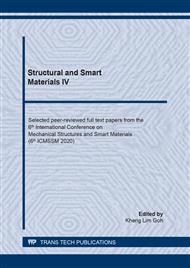[1]
W. Jin, J. Xiaoshi J, Comparison of recent fiber orientation models in Autodesk Moldflow Insight simulations with measured fiber orientation data. Proceeding of the Polymer Processing Society 26th Annual Meeting, Banff (Canada) PPS-26. (2010).
Google Scholar
[2]
J. Musil, Development of Improved Entrance Pressure Drop Technique for Extensional Viscosity Determination. Master Thesis, Tomas Bata University in Zlín (2008).
Google Scholar
[3]
R. B. Bird, R. C. Armstrong, O. Hassager, Dynamics of polymeric liquids. ISBN 0-471-80245-X.
Google Scholar
[4]
A. Sillem A, Fundamental Theory and implementation of the Wang-O´Gara-Tucker model for the modeling of fiber orientation in fiber filled injection molded thermoplastics. MSC thesis mechanical engineering, Delft University of Technology (2010).
Google Scholar
[5]
H. Miled, L. Silva, T. Coupek, J.-T. Agassant, Injection moulding of fibre reinforced thermoplastics: integration of fibre orientation and mechanical properties computations. 27th World Congress of the Polymer processing Society, Marrakech: Morocco (2011).
DOI: 10.3139/217.2602
Google Scholar
[6]
M. Brdlicka, L. Samek, B. Sopko, Mechanika kontinua. ACADEMIA 2005. ISBN 80-200-1344-X.
Google Scholar
[7]
O. Babatubde, A. David, Observed deviations between classical and novel mathematical models for predicting fiber orientation in injection molded composites. (2011).
Google Scholar
[8]
M. Holik, Optimalizace analytických postupů pomocí Plackettova-Burmanova plánu, Masaryk University in Brno (2010).
Google Scholar
[9]
O. C. Zienkiewicz, The Finite Element Method. McGraw – Hill Book Company 1977, ISBN 0-07-084072-5.
Google Scholar
[10]
J. Linn, The Folgar-Tucker model as a differential algebraic system for fiber orientation calculation. Fraunhofer Institut Techno- und Wirtschaftsmathematik (2005).
Google Scholar


